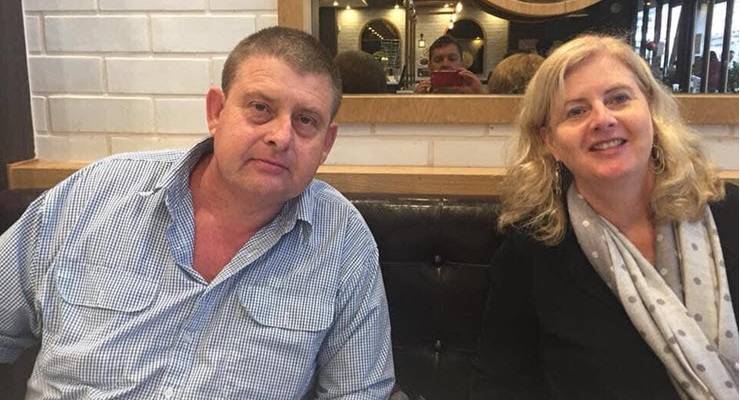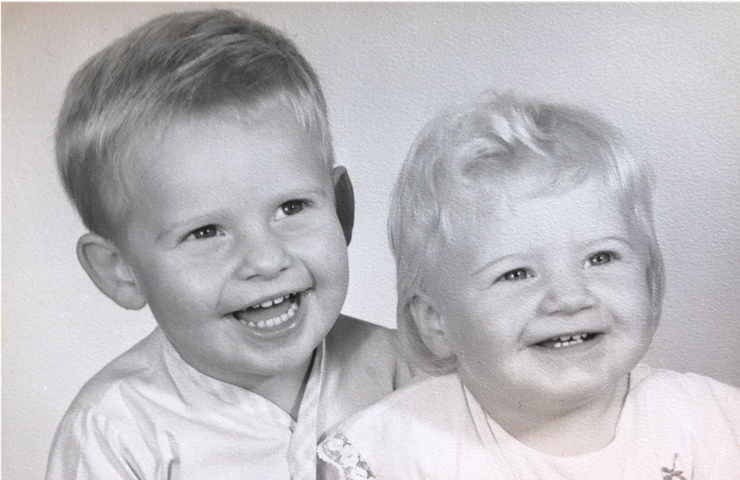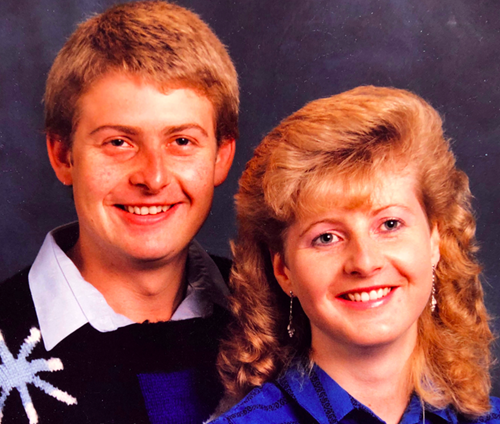
David Harris died alone in his kitchen in early 2019. Found in July, his body was so decomposed that the coroner could not say exactly what day he died or how. He was 55, and for 35 of those years, western Sydney’s mental health system did its best to help Harris cope with severe schizophrenia.
Or did it?
By the time he died, Harris had lost access to all but one of the services which had kept him in this world. Bounced from service to service as programs were defunded — sometimes referred to some that didn’t even exist — the amount of care and contact Harris had with the community was cut back at every step.
Quiet and withdrawn, a common symptom of schizophrenia, he was unable to fight for better services when the ones he relied on were defunded. Yet he needed them to cope.
Within the last five years of his life his sister, nominated carer, and last remaining family member, Leanne Longfellow said Harris had become very reserved.
“Talking with him was a challenge… he didn’t like to answer the phone so we’d sent letters,” she said. “He was my brother and I loved him very much.”
By early last year the only service provider he had left was the National Disability Insurance Scheme (NDIS). Within days or perhaps weeks of that being cancelled — because he had stopped answering phone calls and, it appears, his provider had not bothered to find out why — he was dead.
Losing the NDIS lifeline kept him in contact with the outside world. Instead, Harris, unable to be heard or unwilling or incapable of speaking out, sank into oblivion.
A police report notes that when conducting a welfare check, “police were immediately aware of the smell of decomposition”. Yet his neighbours, living with severe mental illness themselves, hadn’t noticed.
His cleaner had last stopped by on April 1, the week before Harris’ NDIS funding was cut.
Australia’s mental health support system is fractured and dysfunctional. Information is not passed from service to service. Community workers, untrained and underpaid, have little experience dealing with the complex needs of those living with mental illness.
Hospitals and rehabilitation centres, underfunded and over capacity even before COVID-19, are ill-equipped to deal with mental health patients.
Patients often fall through the cracks. David Harris fell as far as possible due, as Inq has discovered, to at least five separate failures in the web of care designed to help him. But his is not the only case.
There are stark parallels between his case and disability care recipient Ann Marie Smith who died last month from severe neglect. Both were failed by a system designed to protect them. Both should still be alive today.
What happened to them, should not be forgotten.
NSW Mental Health Review Tribunal board member Rob Ramjan told Inq without assertive carers and properly trained support workers, there’s a risk of cases like Harris’ repeating themselves.
“When you look at people with severe and persistent mental illness, you’re looking at high vulnerabilities and a high-risk person … the risk of them deteriorating is huge.”

A bright, quiet boy
Throughout the ‘80s and ‘90s, Harris flitted in and out of the sandstone buildings of Cumberland Hospital, one of Australia’s last dedicated psychiatric hospitals run by Western Sydney Mental Health Services.
Harris lived with lifelong paranoid schizophrenia, major affective disorder and bouts of depression. He developed diabetes, hypertension and a few other physical illnesses. But it wasn’t always so.
Before his illness developed, Harris was a happy, academically gifted boy with a mop of blonde hair. He enjoyed reading sci-fi books and building go-karts to push around the streets of Guildford West, a small, quiet suburb in western Sydney.
His mental illness began manifesting in high school, childhood friend Mark Yendle told Inq. Incredibly bright, it was a shock when Harris dropped out of school at the end of year 10.
“We noticed a change,” Yendle said. “He was the person I thought would go to uni and be an academic, but he left high school … I remember thinking he was suffering.”
Harris was also a quiet man, unchallenging and unconfrontational. When his illness became more severe, he withdrew even further — a problem given that under the NDIS model, clients are expected to assert what kind of care they want.
From 1998 until 2016, there was little change in Harris’ care. He lived in public housing and was a member of the Community Housing Implementation Programme (CHIP) program where he had regular check-ins and support.
The notes from when Harris was admitted to the system and discharged are strikingly similar: as an inpatient, his schizoid personality was “characterised by feelings of paranoia, having weird thoughts, at times feeling the radio and TV were talking to him”.
When he was discharged 20 years later from Western Sydney Mental Health — 11 months before his death — he had “minor psychiatric symptoms such as voices ‘television is talking about me’” (sic).
Why he was discharged from Granville Community Rehabilitation Centre, where he was sent after CHIP closed down, is unclear. His discharge notes say he did “not show any resistance”, with the consulting psychiatrist explaining “it is time for [Harris] to move forward”.
His sister and nominated carer Longfellow, who lives in South Australia, told Inq Harris had significant disabilities.
“He did not have capacity, could not look after himself, needed support for so many things,” she said. “At times, he would live in his backyard during psychotic episodes. He’d had support for 35 years and it was ripped away.”
When being quiet and complacent can kill you
2016 to 2018 was a tumultuous time for Harris: CHIP was shut down at the end of 2016, replaced by the state-wide Pathways to Community Living Initiative (PCLI).
Several cottages used by mental health patients at the hospital have since been demolished for the Parramatta light rail.
Harris was referred to Granville Community Rehabilitation Centre, where he saw a psychiatrist and registered nurses checked on him at home a few times a week. Within two years, he had been discharged from this service, too.
A spokesperson for Western Sydney Local Health District told Inq patients were only transferred to the care of a GP if they had a suitable level of stability and good links with service providers.
The GP Harris was referred to had closed down six months earlier.
A source within the Western Sydney Local Health District told Inq Harris’ discharge was, tragically, commonplace.
“Community mental health teams mostly around western Sydney are completely flooded with people,” they said.
“People can’t do their jobs well, there’s simply not enough case managers. They’re always discharging people who optimally shouldn’t be discharged.
“If he was quiet he was likely discharged because he wasn’t making trouble … Those in the framework frequently end up in the hospital because they are hazardous, threatening, or there is something else making them a squeaky wheel.”
Funding hasn’t changed much since 1998. While the overall health budget has increased, the percentage allocated to mental health services remains the same at 7.6%.
Unfortunately, for many living with mental health issues, becoming quiet and withdrawn is a symptom of illness — especially in people with schizophrenia.
A complex disease, schizophrenia can’t be cured, consultant psychiatrist and University of Sydney professor Anthony Harris told Inq.
“Over time, people lose their cognitive flexibility and some of their IQ as they go into the illness,” he said. “Their ability to get their lives together goes out the window,” This makes organising NDIS and other social services a nightmare, he said.
In a progress note on Harris’ case, staff from Granville noted that generally, “client’s carers are closely involved in the discharge planning process”.
This was not the case for Harris. He had nominated his sister, Longfellow, as his carer two years prior — but when he was discharged he requested she not be notified.
A knock at the door
Longfellow began worrying about Harris on July 5 — his birthday. He would have been 56. Communication between the pair was spotty. Harris was wary of the phone and preferred to post letters, and bouts of silence were not unusual.
But he would always put his apprehensions aside call Longfellow on his birthday.
“Every year he makes the effort to ring me and this year, he didn’t. I thought, ‘that’s really strange’,” she said.

His mental illness caused Harris to withdraw from social life, and his contact with the outside world was limited. So, at first, Longfellow wasn’t concerned.
“In my mind, I thought that he had all the services and he previously had … I would just ring those services, and they’d check on him,” she said.
She had no idea he had been discharged from most of his support networks.
At the time, Longfellow’s attention had been focused on her daughter, who has respiratory failure and multiple severe disabilities, and was in intensive care (ICU) at the hospital. The same day her daughter was discharged from the ICU, Longfellow called the NSW police to conduct a welfare check.
Three hours later, there was a knock at the door by the South Australia police.
David’s death torments Longfellow, who is a disability advocate and holds a doctorate in education.
She asks if she could have done more, but living interstate, a career, and caring for her own daughter with a disability, combined with David’s reluctance to communicate, meant she couldn’t check in as often as she would have liked.
Like many others, Longfellow put her faith in the systems supposedly designed to protect people like David.
NDIS model unsuitable for psychosocial disabilities
Sydney University Brain and Mind Centre senior lecturer Sebastian Rosenberg told Inq that around the time of CHIP’s closure, there had been a push to shut down psychiatric hospitals like Cumberland and to move everyone onto the NDIS model.
Along the way, many NGOs running community services lost grants and funding, forcing them to shut down. “NGOs say they were already struggling and running on shoestrings,” he said. “This was the straw that broke the camel’s back.”
From Granville Community Rehabilitation Services, where Harris had access to a psychiatrist and regular home check-ins by nurses, he was placed into the care of two NDIS providers, Flourish Australia and Community Connections.
The NDIS model focuses on giving choice and control to people with disabilities and requires self-managed participants to ask for services and shop around for a provider that suits them. The system breaks down when people do not have the capacity to organise appointments or use their funding, as was the case of Harris.
Flourish Australia provided weekly cleaning services and supported Harris in employment until he was too physically unwell to attend in 2018, while Harris saw a support worker through Community Connections. Both were funded by the NDIS.
While Harris’ cleaning services continued until his funding ceased, it’s unclear the last time a Community Connections support worker checked in on him.
A spokesperson for Flourish Australia said even if NDIS funding was cancelled, the company now continues to provide support for clients until a new plan is in place, or the client cancels the service.
Community Connections CEO Melissa Way didn’t respond to Inq’s questions on whether any new policies had been put in place since Harris’ death.
Longfellow said she was told a Community Connections support worker stopped visiting Harris because his phone had been disconnected. Longfellow disputes this. She says she checked Telstra and his phone was still connected.
Ramjan told Inq being assigned an NGO was a lottery: “There are some fantastic NGOs and workers but the level of accountability in both government and non-government services is not what you’d hope for.”
Limited NDIS funding for services meant companies hire cheap support workers — many of whom hadn’t even finished high school, he said.
“People with severe mental illness need an assertive follow-up,” Ramjan said. “You can’t just allow someone to drift and have them not answer the door … The risk of the person deteriorating is huge.”
Requiring people with schizophrenia to fight for an NDIS support package was simply not a solution, Ramjan said.
“A lot of those who qualify have delusions and believe nothing is wrong with them. Why would they apply for a disability package? Straight away there’s a barrier there. The structures are not appropriate. If he doesn’t have the capacity to apply on his own, who is going to help?”
The fight for services
Fighting for better access to care is a familiar theme in Joanne’s* life. She and her husband are the full-time carers of their daughter, Beatrice*, who lives with schizophrenia.
Despite repeatedly asking for an NDIS support worker with experience in psychosocial disability care, no one with adequate qualifications has been assigned.
“It’s difficult to find enough carers with experience in managing people with a severe and complex illness,” Joanne told Inq. “[Many workers] have no idea about the risks or safety issues that might arise with managing someone who has command hallucinations”.
Beatrice requires 24/7 supervision as her condition can deteriorate rapidly.
When she becomes very unwell, Joanne calls the mental health crisis or acute care team. When being advised about whether it was possible to develop a crisis management plan for Beatrice, she was told simply to call the 1800 crisis hotline. “That is the plan,” she said.
Services are so limited, no respite care is available for Joanne’s family.
During Beatrice’s last hospitalisation, she was forced to wait for more than 12 hours in a resuscitation bed in the emergency department until a bed became available in a psychiatric ward. There were no nurses with psychiatric training looking after Beatrice.
When Beatrice is released from hospital, her parents have to update her community health workers and therapist. “There’s no handover,” Joanne said.
“The system doesn’t work. NDIS and in-house health systems don’t work as an integrated system . It’s difficult to join them up.”
If Beatrice was left to the mercy of the system without her parents as carers, Joanne has no doubt: “Beatrice wouldn’t be alive now.”
The five systems which failed
There were five distinct systems which failed Harris.
Shutting down CHIP meant losing vital services and connections. Being discharged from Granville, without informing his carer, meant he lost regular contact with the community.
David had a weekly standing appointment with his GP for injections of paliperidone, a treatment for schizophrenia. When David stopped showing up, his GP did not call to conduct a welfare check.
Ordinarily, those living in housing commissions have annual client service visits. Harris’ units were managed by NSW Health, who provided all of the case management for clients. When Harris was discharged from Granville and lost his NDIS funding, a visit was scheduled by NSW Housing, but it never happened.
Finally, Harris’ NDIS funding — which provided cleaning services, support workers and, when he was able, part-time employment — was cut off. He didn’t respond to phone calls or letters from the NDIS, so they simply cancelled his funding and informed his NDIS service providers.
His NDIS-contracted support worker stopped checking up on him. When, exactly, is still unknown.
An NDIS spokesperson told Inq that under its code of conduct, all providers must “promptly take steps to raise and act on concerns about matters that might have an impact on the quality and safety of supports provided to people with disability”.
An NDIA spokesperson said that after Harris’ death, a new policy was introduced to ensure funding is no longer simply cut off. Plans are automatically extended by 12 months.
An NDIS commission spokesperson said Community Connections would not be investigated: “There were not breaches of the code of conduct by the provider”.
The question remains as to who had responsibility for Harris’ care.
Was it his GP? His NDIS provider? The housing commission, or Western Sydney Mental Health?
In truth, it was all of them. Each service provider had some responsibility to care for Harris but, at each step of the way, each one of them failed.
Mental health services across Australia are struggling financially. Accountability is low, and responsibility of care, like in Harris’ case, is unclear.
The coroner’s court is still deciding whether it will launch an inquiry into Harris’ death. His sister gravely hopes they do.
“I have very few answers. What I want to come out of this is no more people dying because of the gaps in the system.”
*Names changed for privacy








Step 1, politicians mouth platitudes like “we will make sure this sort of thing never happens again!”
Step 2, enquiry/royal commission
Step 3, rc is ignored/deferred
Step 4, repeat, rinse.
You forgot 2 key commandments Mike. Close down and sell any relevant buildings and outsource to the private sector.
As a retired Community Nurse , this story of pain and neglect has enraged me.
Not the fault of one person or department of course, but as the article
states each one of the four departments responsible ; but at each step of the way
one or the other FAILED! What were they thinking! Where are the checks and balances? What happened to “hand-overs”… If they were overloaded with work
someone had responsibility in all the above departments to ensure the safety
and well-being of their clients.
I am now 83yrs old, and have been hospitalised several times in the last 10years.
I noticed that the Nursing Staff – in the main were not that interested in keeping
one comfortable and pain free…..I was very saddened and disappointed in what
I experienced……how are nurses and allied health workers being trained these
days……Something is very very wrong! Thank you Crikey for bringing thhis
story to our attention.
Awful. Thanks for taking the time to tell the story
Second that. This is a comprehensive account of how the system fails us all by using a very human example.
What a tragic story. It is what happens when there is no family member or close friend living nearby who can attempt to navigate a grossly inadequate system on their loved one’s behalf. And I think it has got worse with the introduction of ‘choice’ under the NDIS, something that the mentally ill person doesn’t have the confidence or knowledge to navigate on their own.
I read the email version on my phone and have now read all of Amber’s excellent article. I have a relative with serious mental health issues and there is no doubt she would not be alive if her mother didn’t live close by and keep a constant eye on her. Her care is completely fragmented. She is lucky to have a kind and very competent psychiatrist who looks after her (previous psychiatrists were awful). But she needs is a competent and experienced case manager working for a properly-funded mental health service, a person who can check in on her, get her moving and who can co-ordinate all her other needs – employment, housing, health, general well-being.
Same story as David’s. Highly intelligent and very talented young woman whose first signs of mental illness appeared at puberty – seems to be a common theme – and things haven’t been right since.
IN the early 1980s, the NSW government and all the other states closed nearly all the mental hospitals and replaced them with……nothing. I remember, my sister was in one. Eventually some forms of so called community care appeared staffed with people of limited qualification and in some cases bible bashing fools who should never have been allowed near a person with mental health needs. Those who could not cope or whose families were too old wound up in prison, or homeless.
The outsourcing of care from states to NDIS has shown the worst aspects of for profit care. We have seen plenty of cases, like people charged 300 dollars for a 4WD and driver, when everyone else just drives there for a single visit. It is even worse in the regions.
How can there be no need for a person to have visited this poor man regularly?
To round out this picture OGO, the states closed their psych and intellectual disability institutions over the 80’s and 90’s. Put simply, the powers quickly realised if you tipped psych patients onto the streets most would sort of survive for a while. If you did the same with the intellectually disabled many would die quite publicly and quickly.
ID people were given lots of group homes in the suburbs. Psych people got a mish mash of community based care mostly not residential and not with ongoing funding.
In fairness the institutions didn’t have a good record and were seen as too hard to comprehensively reform. They were also often on land that had become quite valuable as cities expanded.
There’s the real reason:
“They were also often on land that had become quite valuable as cities expanded.”
You don’t interpose lives, particularly fragile lives, between profiteers and their profits. The profits won’t be lost …
OGO & Mark – just as an aide de memoir, the Richmond report came out in 1984.
Who as in office in NSW & Canberra?
The Richmond Report was accurate in its descriptions and the photos did not tell any lies either.
Most of those rundown wrecks are now heritage listed convict built sandstone buildings set on rolling green areas of harbourside land and, yes you could hear the developers preparing to bulldoze and build with their abacus flying, ha ha ha!
The heritage listing put paid to the knock them down crowd and the heritage council of NSW has a reputation of being able to make grown men cry and so they continue to sit untouched mostly.
A friend of mine ia a psychiatric registered nurse, who ran one of the open wards, in the day and I actually still think that things would be safer on the streets and the police should not be the front line for someone off their medications.
If the open ward model continued to exist or a similar system was created then there would be a lot less danger created by mentally ill people off their medications.
The routine was to get everyone up and showered and dressed by 9 am, breakfast was served and medications were dispensed to the patients and the doses were swallowed.
The patients were then free to wander into the grounds, go up Darling St to the library or outside Woolies there was a giant set of chess pieces with the board inset into the footpath, a couple of good bench seats and a shady tree.
If the patient required mid-day medication, they frequently repaired to the Unity Hall pub to take it. The pubs in Darling St Balmain frequently organized them cold water and sometimes a meal.
The patients were required to be back in the hospital grounds by 6pm or sunset whichever was the earlier. The Balmain Town Hall clock was pretty hard to miss as were its chimes.
My friend, if she was on evening shift and someone was late, she would phone each of the pubs ask by name for her patient and then sound like an aggrieved wife saying “No I don’t want to talk to him, could you please tell him, his dinner is on the table”. It worked.
Dinner was served, evening medications dispensed and taken.
Advantages: patients are medicated and their condition monitored which allowed prompt psychiatric, if necessary. They have a safe clean bed to sleep in and a clean place to shower with clean clothes to wear and regular food intakes.
Disadvantages: regimented life, possibility of abuse of power.
Costs the government a lot more, with no business opportunities for friends or relatives of politicians to cash in, as they already have in the childcare center.
These ‘deinstitutionalised’ people are still ‘cared for’ in institutions – they’re called prisons.